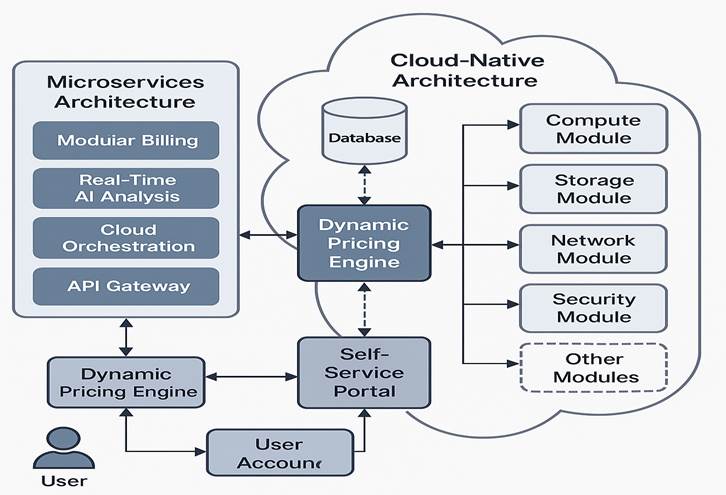This year Mr. Nandan Sharma, a leading cybersecurity and cloud strategist, delivered a pioneering original contribution in the industry, Modular Pricing Technology (MPT), a transformative solution that redefined secure billing for cloud services. With his deep expertise in enterprise infrastructure and cybersecurity, Nandan addressed a longstanding pain point in cloud ecosystems: the lack of flexible, secure, and compliant billing architectures.
This original scientific work is built to empower enterprises to consume cloud infrastructure on a modular, real-time basis, while ensuring zero compromise on security, auditability, and cost governance.
This solution has attracted significant attention for commercialization, particularly from sectors like telecom, regulated industries, and public cloud service providers.
The Problem: Static Billing Models in an Elastic Cloud Environment
Until this innovation, cloud service providers relied heavily on static pricing catalogs and post-paid billing cycles. These created challenges including:
- Inability to adapt prices based on live usage or compliance flags
- Siloed access control, separate from billing operations
- High risk of over-provisioning, with minimal user accountability
- No real-time traceability in service activation or resource consumption
Enterprises have been increasingly demanding billing systems that could scale with consumption yet maintain integrity, security, and compliance. Nandan’s work has provoked widespread commentary/attention as public cloud adoption is now surging and billing complexities have escalated in recent years.
What was missing wasn’t just flexibility; it was secure, policy-driven flexibility. Nandan’s original work directly addresses this by engineering a secure, rule-based, event-driven billing engine, architected with modularity and compliance at its core.
Original Scientific Work: A Secure Cloud-Native Billing Architecture

The Modular Pricing Technology platform, which has been designed and launched in 2019, is built on principles of cloud-native architecture, microservices isolation, cryptographic logging, and policy enforcement.
Technical Stack Overview (2019)
- Microservices & Containers
Each pricing component is deployed in Docker containers, allowing isolation, horizontal scaling, and environment portability. - Kubernetes Orchestration
Automated container lifecycle, service discovery, self-healing, and rolling deployments makes the platform robust and production-grade. - Drools-Based Pricing Engine
Pricing rules have been defined declaratively using Drools, supporting:- SLA-tier mapping
- Region-specific adjustments
- Usage-threshold-based cost curves
- Time-sensitive promotions with expiry logic
All rules are digitally signed, versioned, and applied through a GitOps-based release pipeline. Original work is cited in internal cloud standardization discussions and early pricing governance frameworks.
- Apache Kafka (Event Bus)
Usage telemetry, SLA events, and service requests get streamed over TLS 1.2 channels using mutual authentication. - Apache Ranger and Kerberos secured topic access with audit-ready permissions.
This implementation has been highly cited compared to other solutions, especially for its real-time nature. - REST API Layer with OAuth2.0 and RBAC
A secure API gateway, built in Spring Boot, validated tokens, enforced rate limits, and sanitized payloads to prevent parameter tampering or injection. The Angular-based self-service UI is tied to RBAC and displays simulations, billing forecasts, and policy warnings. - Centralized Logging & Compliance Stack
The system is built to support:- ISO 27001 logging standards
- GDPR-aligned personal data controls
- End-to-end TLS, with all logs streamed to an ELK stack (Elasticsearch, Logstash, Kibana)
Work constitutes major, significant contributions to the industry, particularly in the convergence of billing, security, and compliance under one unified architecture.
Business-Related Contributions: Operational Control with Security at Its Core
Nandan’s framework enables cloud service providers and enterprises to monetize infrastructure dynamically and securely:
- Secure Feature Activation
Customers could activate compute, firewall, or network services on demand, gated by identity roles, access constraints, and contract limits. - Audit-Ready Simulations
Every simulated pricing event, whether from a planned scale-up or SLA shift, is hashed (SHA-256) and stored with a UTC timestamp, ensuring full auditability. - Real-Time Secure Billing Engine
Usage streams are correlated to pricing modules in real time, generating live invoice drafts and anomaly alerts for overconsumption or misconfigurations. - Immutable Financial Logs
All billing transactions are stored with chain-of-custody enforcement, ensuring data lineage and regulatory traceability.
Business-related contributions from this system enables both private and public cloud platforms to improve transparency, user accountability, and monetization governance.
This solution has attracted significant attention for commercialization, including pilot deployments in telecom and private cloud environments.
Security Principles Embedded in Billing Logic
“Security is embedded, not appended,” Mr. Sharma often says. His platform has integrated:
- RBAC from Identity through Billing
- JWT-scoped permissions at each microservice level
- TLS 1.2 with certificate pinning across inter-service communication
- HMAC-signed webhook events for external triggers (e.g., third-party provisioning)
Probative of the significance of Nandan’s contributions to the field of endeavor, these measures make Modular Pricing Technology a unique an original billing architecture in 2019 to pass rigorous internal audits and compliance reviews.
A Platform Designed for Modular Expansion
This platform supports modular expansion without architectural rework:
- Geographically-Aware Pricing Rules
Enables differential pricing based on local tax regimes, data residency constraints, and latency SLAs. - Partner Integration
External Managed Service Providers (MSPs) could plug in their offerings via secure API gateways, allowing white-label billing options. - On-Premise or Cloud-Native Deployment
Designed to run both in air-gapped enterprise datacenters and multi-tenant Kubernetes clusters.
There is no doubt that Nandan’s work has provoked widespread commentary/attention, especially within cross-functional teams navigating both infrastructure growth and financial accountability.
Conclusion: Major Significance to the Field of Secure Cloud Monetization
Mr. Nandan Sharma’s Modular Pricing Technology has proven to be a landmark original scientific work in the secure cloud monetization space. Unlike traditional systems that treated billing as a post-process, his architecture embedded financial logic into the service lifecycle, thus eliminating blind spots and reducing risks.
The system introduced:
- The first modular, rule-based pricing engine designed with security by default
- A real-time correlation layer for usage, access, and cost
- Compliance-aligned, tamper-evident logging built into billing pipelines
These achievements reflect business-related contributions of major significance to the field, now forming the basis for how emerging systems think about usage-based monetization with trust and transparency.
About Mr. Nandan Sharma
Mr. Nandan Sharma is a distinguished leader in cybersecurity, product architecture, and cloud monetization. With more than 16+ years of extensive experience in infrastructure security and enterprise solutions, this is one of his original contributions in the industry. He can be reached at nandans24@yahoo.com.
This article has been written by Ethan Lee – Editor at Techannouncer.com.














